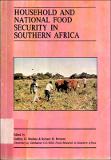| dc.contributor.author | Asefa, Sisay | |
| dc.contributor.author | Gyeke, Agyapong | |
| dc.contributor.author | Siphambe, Happy | |
| dc.coverage.spatial | Botswana. | en |
| dc.date.accessioned | 2016-02-02T16:30:15Z | |
| dc.date.available | 2016-02-02T16:30:15Z | |
| dc.date.issued | 1989 | |
| dc.identifier.citation | Asefa, S., Gyeke, A. and Siphambe, H. (1989) The impact of Botswana's pula for work programme on food access: preliminary findings. In: Mudimu, G.D. and Bernsten, R.H. (eds.) Household and national food security in Southern Africa, pp. 323-330. Harare: DAEE. | en |
| dc.identifier.uri | https://opendocs.ids.ac.uk/opendocs/handle/20.500.12413/8859 | |
| dc.description | A research preliminary findings on the impact of the Pula currency on food for work programmes to alleviate poverty in Botswana, originally presented at The Fourth Annual Conference on Food Security In Southern Africa, 31 October- 3 November, 1988. | en |
| dc.description.abstract | During the past seven years, Botswana has suffered from a continuous drought which had adversely affected its rural economy. In response, the government initiated the National Drought Relief Programme which has four components: human relief (supplementary feeding), agricultural relief and recovery, rural public works or pula2 for work, (also known as labour-based relief), and a water supply programme.
The National Drought Relief Programme is coordinated by an Inter-Ministerial Drought Committee (IMDC) that comprises representatives from five key government ministries (Finance and Development Planning, Agriculture, Local Government and Lands, Education, and Health). The overall programme is linked to the national planning process by the National Food Strategy (NFS) that was prepared by the Government of Botswana in 1985. Two of the major goals of the NFS are to ensure a minimum acceptable diet for all of the population and to build a national capacity to contain the adverse effects of the recurrent drought (Botswana, 1985).
The focus of this study is on the pula for work component of the Drought Relief Programme, which originated in 1982 and is currently administered by the Food Resource Department in the Ministry of Local Government and Lands (MLGL). This single largest component of the National Drought Relief Programme has been allocated about P18 million (US$11 million) since its inception. | en |
| dc.language.iso | en | en |
| dc.publisher | University of Zimbabwe (UZ) Publications/ Michigan State University (MSU) | en |
| dc.rights.uri | http://creativecommons.org/licenses/by-nc-nd/3.0/ | en |
| dc.subject | Finance | en |
| dc.subject | Work and Labour | en |
| dc.title | The impact of Botswana's pula for work programme on food access: preliminary findings | en |
| dc.type | Book chapter | en |
| dc.rights.holder | University of Zimbabwe (UZ)/ Michigan State University (MSU) | en |


